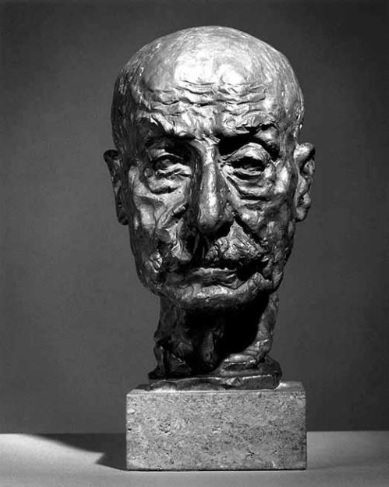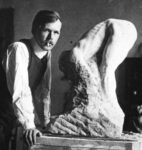
Georg Kolbe
German, 1877-1947
Max Liebermann, 1929
bronze
12 x 7 x 8 in.
SBMA, Gift of B. Gerald Cantor Art Foundation
1985.28

Photograph of the artist, courtesy of the Georg Kolbe Museum, Berlin
RESEARCH PAPER
This is a portrait bust of Max Liebermann, a prominent painter of the late 19th and early 20th century, executed by Georg Kolbe, a fellow artist and highly accomplished print maker and sculptor. Both were members in the “Berlin Secession,” a group of painters and sculptors who championed modern and international art contrary to the traditional teachings of the Royal Academy of the Arts of Berlin from which they seceded in 1899.
Description of work of art at SBMA:
Kolbe sculpts Max Liebermann’s bust with a slightly downward looking head, the prominent folds of his skin expressively depicting the likeness of the more than 80-year-old painter. The material of the metal rends itself well to emphasize shadows and highlights in the sagging and wrinkled face formed and molded by the sculptor’s hands in the early process of its creation. The hollows and ridges on the darkly patinated bronze head create expressive shadows and highlights animating the face. The raised, thick eyebrows defy the aging painter’s heavy-lidded eyes as they draw the viewer’s attention to the artist’s insistent gaze upon life around him.
Georg Kolbe started out as a painter at the Munich Academy of Art. In 1897 he went to Paris to study at the Académie Julien. The artist’s main interest was always the female nude. He became a highly accomplished printmaker of the subject. After a one-year stint of independent study in Rome, he settled in Berlin and began to translate his drawings into the medium of bronze. Initially, he preferred to cast graceful dancers in motion moving to a more stylized expression of the female form as his style changed. Simultaneously, he created portrait busts of his fellow artists and other members of Germany’s artistic elite becoming one of the most important portraitists of his time. Max Liebermann’s highly animated portrait is one of them. Initially sought after for his depictions of a lyrical interpretation of the female nude, Kolbe continued to be successful as he altered his style from an Expressionist phase in the 1920s to a more naturalistic affirmation of the human form in the 1930s.
Celebrated as one of Germany’s modern artists and a sculptor of the classic-type nude, he was admired as well by the National Socialist art connoisseurs. Although Kolbe remained essentially apolitical during Hitler’s regime, and several of his earlier, more expressive sculptures were removed from public view by the regime, Kolbe successfully exhibited his work in the Great German Art Exhibitions in Munich beginning with the first of the annual events in 1937. Questions remain whether he altered his style in the 1930s to conform to the prescribed ideal of the Third Reich’s aesthetic demands and if so to what extent this might warrant a critical revision of the artist’s oeuvre. (Papers from a recent conference regarding Kolbe’s artistic integrity will be published sometime in 2023)
Max Liebermann, 1847-1935
Max Liebermann came from a distinguished German-Jewish family established for generations in the capital of Germany, Berlin. Expected to complete his university studies in the field of law, he came to painting later in life. He began his studies at the Royal Saxon Art School in Weimar in 1870, but soon abandoned academic rigid rules and freed his artistic inclinations by searching out the works of the French Realists and Impressionists. Beginning in 1873 he immersed himself in the study of Camille Corot, Troyon and Daubigny and he admired the idealized rural scenes of Millet, whom he met. He travelled to Holland repeatedly to paint the daily life of working-class people. From 1875 onward, repeated trips took him through France and Holland developing a personal style of painting not yet practiced in Germany where the conservative rules of the Prussian Academy still held sway over conventional, nineteenth-century idealism. His first publicly shown painting, “Women Plucking Geese” shown at the Kunsthalle in Hamburg in 1872 was not well received because of its “poor” subject matter and dark color. Although deemed the “disciple of the ugly” because of his chosen subject matter, his uncompromising Realism combined with the French-Impressionist inspired painting style gained him recognition as one of the most celebrated innovators of German modern art at the end of the 19th century.
At times categorized as a “Social Realist”, Liebermann himself appeared distant from his subject matter; his depiction of simple family life or scenes from the daily drudgery of those less fortunate was not meant to be moralizing. The pursuit of a certain subject matter was rather an expression of the painter’s search for a universal truth. It guided his artistic instinct to make visible the lives of “others.” With the feathery use of his brush, the flickering light on the surface of the paint, “the apostle of the ugly” made it ever so pleasant for the viewer to experience the labor and routine of a large segment of society in an uplifting fashion.
Max Liebermann founded the “Berlin Secession” in 1899, a breakaway collective of artists who backed modernist styles, like Impressionism. In 1920 he became President of the Berlin Academy of Art, a post he was forced to resign from due to the National Socialist Party’s antisemitic laws. The artist died in his home at Lake Wannsee, Berlin in 1935, where the “Liebermann” museum is now housed.
Prepared for the Santa Barbara Museum of Art Docent Council by Ursula A. Ginder, PhD., February, 2023
Bibliography
“Georg Kolbe. Sculpture from the Collection of B. Gerald Cantor.” Cornell University/Andrew Dickson Museum of Art, Ithaca, N.Y., 1972.
Ginder-Aulinger, Ursula. “Degenerate Art Exhibition: Kunststadt Muenchen 1937.“ University of California Santa Barbara, 2011.
“Grosse Deutsche Kunstausstellung 1937 im Haus der Deutschen Kunst zu Muenchen. 18. Juni bis 31. Oktober 1937.” Muenchen. Knorr & Hirth GmbH, 1937.
Lenz, Christian. “Die Deutschen Impressionisten.” Die Neue Pinakothek Muenchen. Scala Publications Ltd., London, 1989.
“Neue Pinakothek Muenchen.” Bayerische Staatgemaeldesammlungen, Muenchen, 1982.
The Museum of Fine Arts, Houston. “German Impressionist Landscape Painting:Liebermann-Corinth-Slevogt.” Nov 11 – Dec. 5, 2010.
Tomasella, Adrianna. “Max Liebermann: A Leader of the German Impressionist Movement.
Ibi.org/de/collections/Max-Liebermann.
SBMA CURATORIAL LABELS
This portrait of the painter, collector, and president of the Prussian Academy of Arts was done two years after a triumphant exhibition of his art was held in Berlin and four years before Liebermann’s art would be banned from Germany because of his Jewish ancestry. Kolbe was commissioned by Liebermann for this bust portrait, in exchange for which Liebermann traded him two works of his own. Like the older French sculptor, Auguste Rodin, whose studio he visited briefly in 1909, Kolbe retains the passage of his grasping fingers. The roughly finished surface communicates a sense of intimacy between sitter and sculptor, who sensitively recorded the life experience etched on his sitter’s aging features.
- Ridley-Tree Reinstallation, 2022
